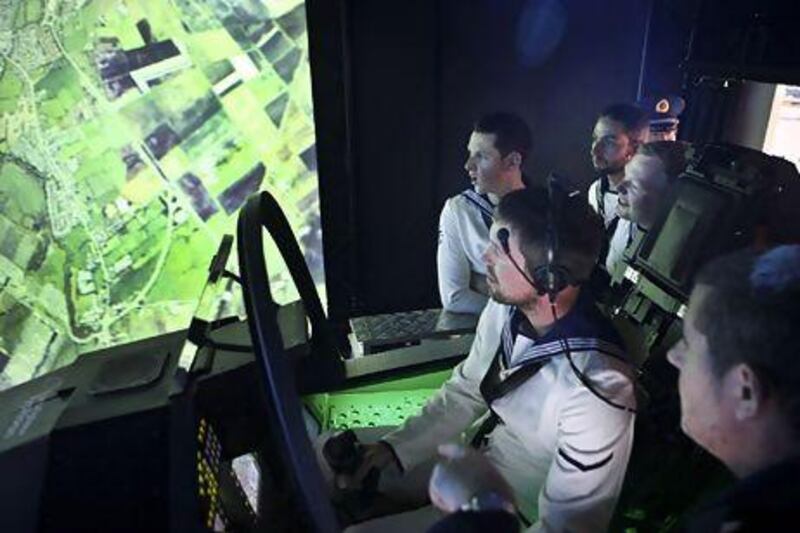I blew up the Heysham 2 nuclear power plant in Lancashire, England, yesterday.
It was a bittersweet moment as I unleashed the BK-27 Mauser cannon mounted on my Typhoon Eurofighter and remembered that the strategically important atomic facility was only about 8 kilometres from my father's house, which would certainly have been destroyed in the blast.
Not long after this somewhat emotional realisation, I ditched the US$60 million (Dh220.3m) Eurofighter, and the cutting edge heads-up display helmet that comes with it, into a farmer's field. The auto-ejection system saved my skin though, and I apparently floated down to land somewhere off Morecambe Bay.
This unusually personal flight of fancy in fact took place in the middle of a crowded Abu Dhabi National Exhibition Centre on the first day of the International Defence Exhibition and Conference 2013 (Idex).
The Eurofighter simulation was a popular attraction and probably the most technologically advanced piece of kit on display at the event. It was certainly among the most expensive.
Sitting in the cockpit wearing a Typhoon Helmet Mounted Symbology System, it was remarkably easy to get the hang of flying a jet at the speed of sound, barrelling and rolling around the skies, tracking an enemy jet with nothing more than a turn of the head and destroying it with the mere twitch of an index finger.
But there were countless examples of similarly sophisticated and technologically advanced equipment at every turn throughout the vast exhibition hall.
Most prominent were the dozens of examples of unmanned vehicle systems. From tiny propeller-driven airborne drones that look like they could land in the palm of your hand to big glider-sized aircraft produced by Abu Dhabi's Adcom Systems, such drones were clearly among the stars of the show.
Abu Dhabi's Al Tuff Industries also had on display a complete unmanned navy with waterborne drones capable of patrolling ports and coastlines. The sleek black naval robots looked as if they had sailed straight off the set of a Star Wars movie, with Darth Vader at the controls.
Farther afield, in the Australian defence industries area, another group of robots lurked. The Marathon Smart Targets - the torso and head of a tailor's dummy mounted on a four-wheel-drive vehicle - looked less Star Wars and more Metal Mickey.
Each one wore a sweatshirt, face mask and baseball cap for authenticity. But for all their clunkiness and unkempt appearances, the Smart Targets are just as cutting edge as any drone.
The target robots react autonomously to noises and other stimuli, giving soldiers the ability to train shooting at targets that behave like people without actually having to kill anyone.
Raytheon, the American defence giant, had a huge array of weapons on display but perhaps its most interesting piece of technology was a translation device ripped from the pages of A Hitchhiker's Guide to the Galaxy, the Douglas Adams novel. Adams imagined a creature called the Babel Fish that, once inserted in the ear, would simultaneously translate all the languages it heard allowing free communication throughout the universe.
Raytheon's TransTalk isn't quite that good but it does a pretty good job. The United States army has been using it at checkpoints and in villages across Afghanistan with impressive results.
The technology is housed on an Android phone that displays two flags, one to represent each language to be translated. The user simply touches one flag, speaks and the phone translates.
Not all the technology on display at Idex this year contains microchips and fibre-optic cabling, however. A German company called Blücher had on display remarkable underpants that were said to be "ballistic protective".
"The material matrix of the extreme lightweight pants meets soldiers' requirements both in highly active and relaxed situations," the publicity material said.
But it was the Russians who claimed to have the most reliable weapon in the whole exhibition. The Kalashnikov rifle - otherwise known as the AK-47 - has been firing off rounds with regular precision since 1949.
"When there is no war countries invest a lot of money in these very advanced weapons systems that we see here," said Andrey Baryshnikov, the director of international sales for Izhmash, the company that makes the Kalashnikov.
"But what an officer and a soldier needs is a weapon that he knows will fire and hit the target when he wants it to. Kalashnikov does that."





